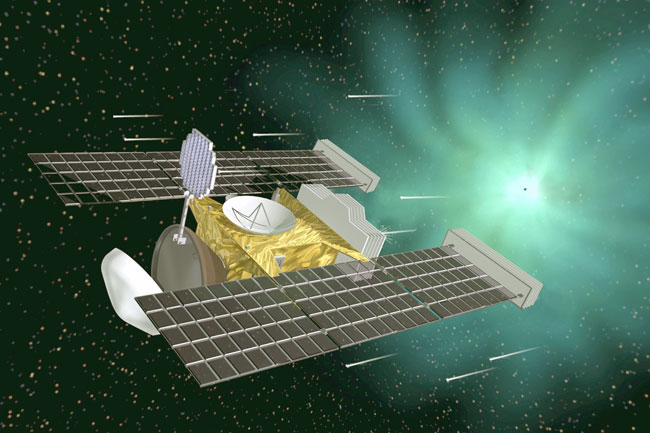Astronomers Imagine Comet's Birth

In the weehours of our solar system, massive explosions on the sun might have sentfree-floating gases whizzing at such high speeds that they embedded into tinyrock particles. These "rocklets" were then transported beyond Neptune and incorporated into a comet, researchers said today.
Newresearch reveals surprisingly large amounts of the noble gases helium and neonin samples taken from comet Wild 2 (pronounced "Vilt 2"). Theresults, detailed in the Jan. 4 issue of the journal Science, suggestthe gases came from a region very near the young sun, say the researchers.
Noble gasesare a group of six elements that don't react with other elements. Since theyare stable, noble gases are great "tracers" of chemicals from variousparts of the solar system.
Preliminaryexamination of the comet samples, returned to Earth by NASA's Stardust mission in2006, had revealed so-called igneous rock particles that only form underhigh-temperature conditions. On Earth, igneous rocks form when magma cools andsolidifies, either after erupting from volcanoes or tucked beneath layers ofearth.
Soastronomers had previously concluded the particles that later got incorporatedinto Wild 2 formed very closeto the sun, probably within the first million years of our solar system'shistory.
The newresearch "further characterizes the environment that they were in at thetime they were formed," said study researcher Robert Pepin of the School of Physics and Astronomy at the University of Minnesota.
Odd-shapedblobs comprising a mix of dust grains and frozen gases, cometsmay be the oldest, most primitive bodies in the solar system. They hold theearliest record of material from the nebula that formed the sun and planets.
Get the Space.com Newsletter
Breaking space news, the latest updates on rocket launches, skywatching events and more!
While thegrains in Wild 2 spent most of their lives in the frigid, distant reaches ofthe solar system, they were likely captured in "rocklets" that formedvery close to the sun. Until recently, Wild 2 circled the sun in an orbitbetween Jupiter and Uranus, but in 1974 a close encounter with Jupiter sent thecomet into an orbit that brings it closer to the sun.
Whatembedded the atoms of helium and neon into these rocklets? The researchers sayintense radiationnear the sun. "Not only was the environment hot, but it appeared tohave been characterized by a lot of radiation which probably came from immense,early, magnetically driven solar flares very close to the sun," Pepin toldSPACE.com.
Theradiation, he explained, apparently accelerated particles of gases to such highspeeds they embedded themselves into the little grains.
Even thoughthe comet particles formed in the sun's neighborhood, the chemical makeup ofthe embedded noble gases looked nothing like solar material. Instead, the ratioof different forms of the helium and neon resembled that found in certainprimitive meteorites, according to the researchers.
- Video: Comets Through Time?Myth and Mystery
- The Enduring Mysteries of Comets
- Image Gallery: Comets
Join our Space Forums to keep talking space on the latest missions, night sky and more! And if you have a news tip, correction or comment, let us know at: community@space.com.










